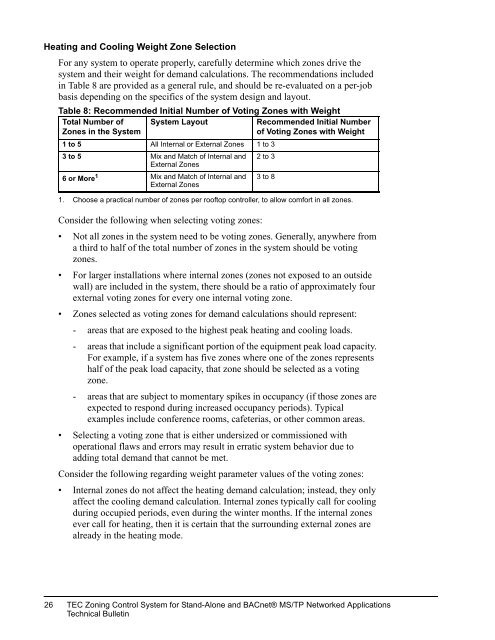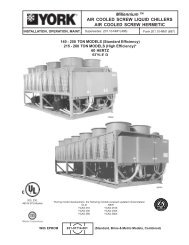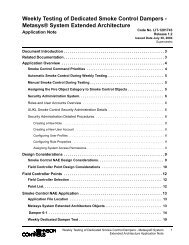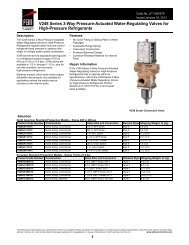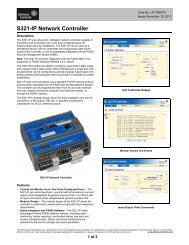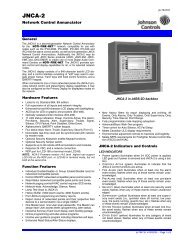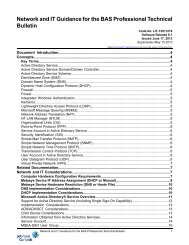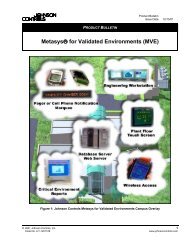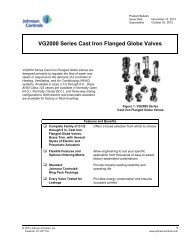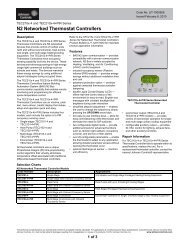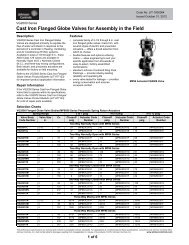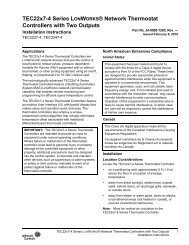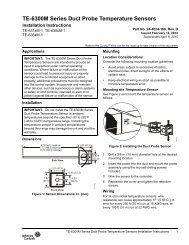TEC Zoning Control System for Stand-Alone and BACnet® MS/TP ...
TEC Zoning Control System for Stand-Alone and BACnet® MS/TP ...
TEC Zoning Control System for Stand-Alone and BACnet® MS/TP ...
- No tags were found...
Create successful ePaper yourself
Turn your PDF publications into a flip-book with our unique Google optimized e-Paper software.
Heating <strong>and</strong> Cooling Weight Zone SelectionFor any system to operate properly, carefully determine which zones drive thesystem <strong>and</strong> their weight <strong>for</strong> dem<strong>and</strong> calculations. The recommendations includedin Table 8 are provided as a general rule, <strong>and</strong> should be re-evaluated on a per-jobbasis depending on the specifics of the system design <strong>and</strong> layout.Table 8: Recommended Initial Number of Voting Zones with WeightTotal Number ofZones in the <strong>System</strong><strong>System</strong> Layout1 to 5 All Internal or External Zones 1 to 33 to 5 Mix <strong>and</strong> Match of Internal <strong>and</strong> 2 to 3External Zones6 or More 1Mix <strong>and</strong> Match of Internal <strong>and</strong>External ZonesRecommended Initial Numberof Voting Zones with Weight3 to 81. Choose a practical number of zones per rooftop controller, to allow com<strong>for</strong>t in all zones.Consider the following when selecting voting zones:• Not all zones in the system need to be voting zones. Generally, anywhere froma third to half of the total number of zones in the system should be votingzones.• For larger installations where internal zones (zones not exposed to an outsidewall) are included in the system, there should be a ratio of approximately fourexternal voting zones <strong>for</strong> every one internal voting zone.• Zones selected as voting zones <strong>for</strong> dem<strong>and</strong> calculations should represent:- areas that are exposed to the highest peak heating <strong>and</strong> cooling loads.- areas that include a significant portion of the equipment peak load capacity.For example, if a system has five zones where one of the zones representshalf of the peak load capacity, that zone should be selected as a votingzone.- areas that are subject to momentary spikes in occupancy (if those zones areexpected to respond during increased occupancy periods). Typicalexamples include conference rooms, cafeterias, or other common areas.• Selecting a voting zone that is either undersized or commissioned withoperational flaws <strong>and</strong> errors may result in erratic system behavior due toadding total dem<strong>and</strong> that cannot be met.Consider the following regarding weight parameter values of the voting zones:• Internal zones do not affect the heating dem<strong>and</strong> calculation; instead, they onlyaffect the cooling dem<strong>and</strong> calculation. Internal zones typically call <strong>for</strong> coolingduring occupied periods, even during the winter months. If the internal zonesever call <strong>for</strong> heating, then it is certain that the surrounding external zones arealready in the heating mode.26<strong>TEC</strong> <strong>Zoning</strong> <strong>Control</strong> <strong>System</strong> <strong>for</strong> <strong>St<strong>and</strong></strong>-<strong>Alone</strong> <strong>and</strong> <strong>BACnet®</strong> <strong>MS</strong>/<strong>TP</strong> Networked ApplicationsTechnical Bulletin


